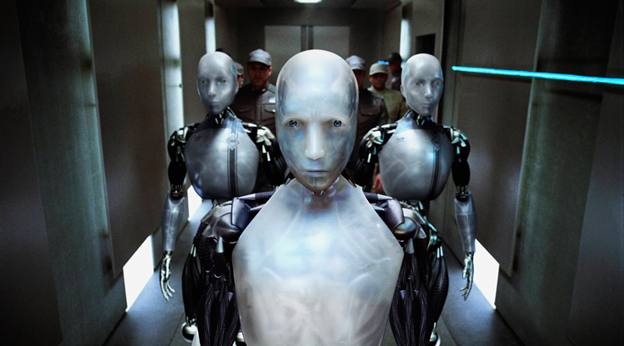
The Robots Are Taking Over
The growing problem of fraudulent web traffic
Do you know if your readers are humans or robots? With nearly 1/3 of all web traffic potentially fake, it’s a question that is becoming less clear every day.
Fraudulent traffic is a major, and growing, problem for online advertising—for both the brands shelling out big bucks for advertising space and for the publishers accepting it. Traffic fraud, and its evil stepbrother click fraud, have existed since the earliest days of digital advertising. For advertisers, click fraud not only significantly skews the key performance indicators determining campaign success, but it burns through budgets at an incredible rate. How do you know if your brand’s message is actually being heard when the audience has no eyes or ears?
In his piece “Fraudulent traffic: adventures in ad farming,” Jack Marshall of DigiDay.com proved that it’s easy as pie to create fraudulent traffic. His experiment showed that buying traffic from websites such as MaxVisits.com help you gain quick and cheap traffic, but even MaxVisits.com couldn’t identify from where that traffic was coming from. This experiment is eye opening, but it sure isn’t comforting.
Who’s responsible for traffic fraud?
Is it one bad robot overlord causing all the problems? Sadly, traffic fraud occurs in multiple ways, making it even harder to track and contain.
Tracking bots is an uphill battle, fraudsters tend to come up with new tricks faster than security software can shut them down. This makes it very difficult to know the exact percentage of fake traffic out there, but most experts agree, it’s significant. Estimates in a recent Wall Street Journal report peg it at over 30% of all web traffic. Regardless of the exact number, both advertisers and publishers are paying immensely for it.
The motivation for fake traffic is easy to see, fraud can be extremely lucrative. According to Ryan Holiday at BetaBeat “The game is thus: You can buy traffic for less than a penny per visit from a vendor of dubious quality, because you know you have essentially an unlimited standing offer from advertisers that value those impressions at a penny plus.” Although it may seem that it is only the advertiser holding the bag at the end of the day, the story isn’t as simple as Coca Cola overspending on advertising. No, as supply increases, rates drop and the publisher needs to continually buy more and more traffic to fulfill Coca Cola’s quota in a race to the bottom. See the vicious circle?
It’s wasted money in a game that no one wins.
Why isn’t it easy to spot?
In online advertising, ad servers are used to manage where ads will be displayed on the web. The trouble begins because ad servers recognize if an ad has been served to the page, not if it’s been displayed. What does this mean? It means that a bot is possibly on the other end of those page views and clicks. A recent study by ComScore found that 54% of display ads never appear in front of a human being. The ad either never actually showed up on a computer screen (unviewable) or the traffic came from automated bots.
Sometimes traffic fraud comes from ad servers misdirecting display ads. A February 2014 Business Insider article, detailed how major brands like Proctor & Gamble and Kellogg’s ended up on X-rated websites. In the ComScore VcE study 72% of all campaigns were found to have some impressions displayed adjacent to “objectionable content”. That means that in an average online advertising campaign the advertiser ends up paying not only for fake impressions but in the case of unsafe sites, is even paying for impressions that they would rather never existed, even if they were free.
Humans acting like robots
Unfortunately, sometimes bots aren’t the only problem, some humans are also doing the damage.
In Dhaka, Bangladesh, there exists a Click Farm called Unique IT World. In January 2014, The New York Post reported that the CEO of Unique IT World said “he has paid workers to manually click on clients’ social media pages, making it harder for Facebook, Google and others to catch them. “Those accounts are not fake, they were genuine”, Shaiful Islam stated. True, the accounts may belong to actual people, but these people are not legitimately interested in your ads or Facebook posts.
People being paid to like Facebook updates, watch YouTube videos, and retweet comments on Twitter, profiting from every click of the mouse. So much for social media being, well, social.
Not enough bad news for you? It’s about to get worse as we process transactions and serve ads increasingly through programmatic means. Dushan Batrovic from Difference Capital explains that with programmatic buying, it’s best to think of every single website impression as a live auction. These websites have collected scores of data about their users (*cough* Facebook). Based on this collected data, advertisers bid on advertising space that matches their target demographics. Of course, this is an automated auction, so every sale happens in 5-10 milliseconds. With humans taken out of the picture, fraudulent programs are using these well-meaning programmatic bots to scale up their dirty work.
“We’ve had enough” says Google, the online ad industry and YOU
The good news is that we humans all agree—the current ecosystem isn’t working. The robots are winning and in the long run everyone except the fraudsters will lose. Advertisers are aware that they are being duped, and it is being built into the declining price of ads. Publishers are seeing their true, loyal readership, diluted in a flood of useless pageviews.
The Interactive Advertising Bureau (IAB) works hard to deal with fraudulent traffic. Initiatives have been put in place to find solutions. Making Measurements Make Sense (3MS) is one of the initiatives striving to revolutionize how impressions are determined. On March 30, 2014, the Media Rating Council (MRC) lifted their ban on using Viewable Impressions as a transactional metric for advertisers. This is as a result of pressure from the 3MS. Viewable Impressions are a potentially more accurate way to measure who or what is viewing your ad. The MRC’s guidelines state that 50% of the ad must be visible in the internet browser for a minimum of one continuous second. It’s a start.
Google is serious about traffic fraud too. In February 2014, Google acquired Spider.io — a London-based startup that identifies prevalent bots such as the now infamous Chameleon Botnet. Chameleon was costing advertisers an estimated $6.2 million per month.
A move to a more human set of metrics
While the Googles of the world work hard to use robots to kill the other robots, others are trying something a bit more radical, and at the same time, very human. What if we moved away from clicks and ad impressions altogether?
Brand objectives haven’t changed in the move to digital, the vast majority of companies are simply trying to reach the right audiences. Brands want to speak to real people that make real decisions and hopefully that decision will involve their product or service. Content marketing is growing at an incredible rate as brands look to provide valuable content to potential customers along their path to purchase. With a groundswell movement away from ads and towards stories, the metrics are evolving too. The time spent, how a story is shared and the conversation that surrounds it become the new holy grail, attention and influence over clicks and impressions. When we start to look at how a person reads an article and passes it along to their friends, we get closer to characteristics that are innately human and move further away from the bots. If an article takes 5 minutes to read, isn’t it reasonable to believe that a human would spend that much time with it?
There is a rethinking of publishing and advertising online. The banner ad has had its moment in the sun, over two decades to be exact. Why don’t we let the robots take that one over for good, we can all move onto something a lot more human, we can get back to the stories.
Get your Content Marketing Fix
Sign up to receive tips on storytelling and much more.
We promise to respect your inbox.



